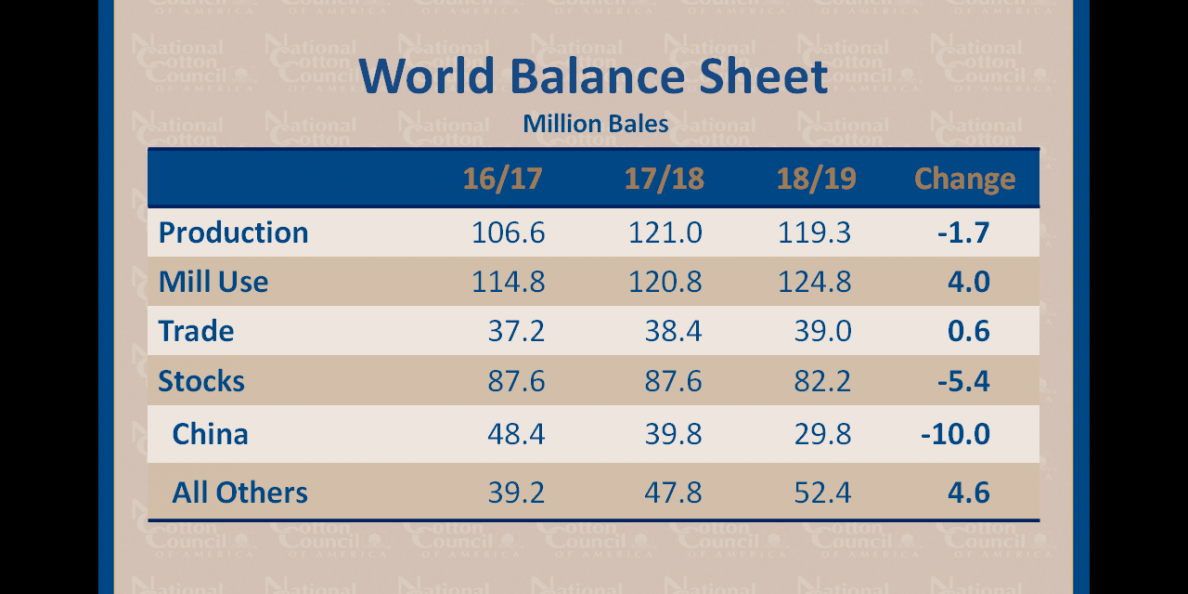NCC economists point to a few key factors that will shape the U.S. cotton industry’s 2018 economic outlook.
MEMPHIS, Tenn. – National Cotton Council economists point to a few key factors that will shape the U.S. cotton industry’s 2018 economic outlook. In recent months, cotton prices have maintained a stronger appearance despite the increase in world production. Although the current supply and demand fundamentals appear somewhat bearish, strong U.S. export sales, a weaker U.S. dollar, heavy speculative buying, and large mill fixations have supported prices. For the coming year, projections of record ending stocks outside of China could pressure prices.
Looking longer term, several positive factors point to a more optimistic outlook for the cotton industry over the next few years. The world economy is improving and stronger growth is projected in 2018 and 2019. World cotton demand is increasing with current estimates calling for an increase of approximately five percent in 2017, which is more than double the previous five-year average. China will begin the next round of reserve auctions next month. A successful auction series in 2018 could easily position China to become a larger cotton importer again.
Dr. Jody Campiche, the NCC’s vice president, Economics & Policy Analysis, told delegates at the NCC’s 80th Annual Meeting in Fort Worth, Texas today that, “World mill use is expected to exceed world production in the 2018 marketing year, and global cotton stocks are projected to decline by 5.4 million bales in the 2018 balance sheet.” In the NCC’s annual Economic Outlook, she noted the global stocks decline is due to reduced inventories in China. China’s stocks are declining with USDA estimating a drop of 8.0 million bales in 2017. In 2018, an additional 10.0 million bale reduction in total stocks is expected.
She said world production is projected to be 119.3 million bales in 2018. World mill use is projected to increase by approximately three percent in 2018 to 124.8 million bales with most of the growth from China, Vietnam and Bangladesh. While projections of global consumption exceeding production normally would be supportive of prices, the implications for the coming year may not be as clear cut as stocks outside of China are projected to increase by 8.6 million bales in 2017 and 4.6 million bales in 2018.
Regarding domestic cotton mill use, Campiche said 2017 U.S. mill use is estimated at 3.4 million bales, up 100,000 bales from 2016. The Economic Adjustment Assistance Program continues to be an important source of stability allowing mills to invest in new facilities and equipment. For 2018, the NCC is projecting a modest increase in U.S. mill use of 60,000 bales.
She noted that export markets continue to be U.S. raw fiber’s primary outlet. The United States will remain the largest cotton exporter with a market share of 39 percent in 2017 as compared to 40 percent in 2016. China is currently the top export market for the 2017 crop year, followed by Vietnam and Pakistan. World trade is projected to be higher in the 2017 marketing year, but increased competition from other major exporting countries has led to a decline in the U.S. market share.
U.S. export sales have been very strong with early sales surpassing recent crop years. For 2017, the NCC estimates U.S. exports at 15.0 million bales, up 0.6 percent from 2016. However, shipments have been lagging behind sales during the first half of the marketing year. While several factors led to shipping delays earlier in the marketing year, trucking shortages, along with increased trucking costs, currently are affecting cotton shipments. The shipment pace has increased over the past few weeks and will need to remain strong for the remainder of the marketing year to reach the 15.0 million bale estimate.
Looking ahead to 2018, increased competition from other cotton-producing countries is expected to reduce both U.S. exports and U.S. market share. With exports pegged at 14.3 million bales, Campiche projects total U.S. offtake of 17.7 million bales in 2018, leading to an increase in ending stocks of 1.5 million bales.
In China, cotton mill use has increased, but competition from lower-priced man-made fiber remains a limiting factor for the continued growth of cotton fiber use. Although internal cotton prices are still strong relative to polyester prices, polyester prices increased in 2017 and are currently at the highest level since 2014. China’s new environmentally-friendly policies could also affect man-made fiber production and use.
In her analysis of the NCC Annual Planting Intentions survey results, Campiche said the NCC projects 2018 U.S. cotton acreage to be 13.1 million acres, 3.7 percent more than 2017. With abandonment assumed at approximately 15 percent for the United States, Cotton Belt harvested area totals 11.1 million acres. However, due to the dry conditions that currently persist across the Cotton Belt and the forecasts of abnormally dry conditions throughout the spring, particularly in the Southwest, the final abandonment rate could be higher.
Using an average U.S. yield per harvested acre of 842 pounds generates a cotton crop of 19.4 million bales, with 18.7 million upland bales and 744,000 extra-long staple bales.
However, it is important to note that although the survey results suggest a slight increase in acreage, the increase is largely the result of weaker prices of competing crops. Although cotton prices have improved slightly compared to other crops, cottonseed prices have dropped significantly, thus leading to an increase in net ginning costs. Many producers will continue to face difficult economic conditions in 2018. Production costs remain high, and unless producers have good yields, current prices may not be enough to cover all production expenses.
Additional details of the 2018 Cotton Economic Outlook are on the NCC’s website at http://www.cotton.org/econ/reports/annual-outlook.cfm.



